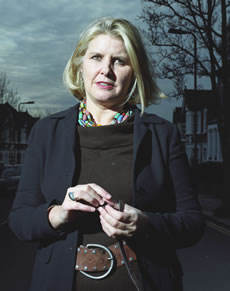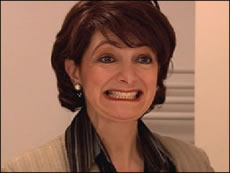Lights, Camera ............... Acton!
One street in Acton comes under the spotlight
Residents of a certain street in Acton will be glued to their televisions on February 21st. Sue Bourne, a remarkable documentary-maker, spent many weeks last year researching and filming a documentary all about the inhabitants of an Acton street. The film will be screened as one of the Cutting Edge series this Thursday.
My Street takes us through 12 Acton front doors and straight into their inhabitants' lives. Sue's empathy for the people she meets is obvious throughout this compelling and all-too-short film. Her portraits of people are gentle and revealing. In fact, she shares more with her subjects than most directors as she, too, lives on the Acton street where the film was made.
Sue told me she had wanted to create something reminiscent of an advent calendar. "I was convinced I could make it work, although some people were very disparaging when I was trying to get the commission to make the film. More than one person told me: "Nothing will come of this", and others told me I was mad to expose myself or that I was making myself vulnerable." But she refused to give up: "As a documentary-maker you have to believe in what you do."
Before My Street, the film Sue has been most proud to have directed and produced was called 'Wedding Days.' This film was a series of interviews with 20 couples who all started their married life in the same place: on the same wedding announcement page of the Brighton and Hove Express. The interviews were filmed 25 years afterwards and contain a revealing shapshot of marriage over a quarter of a century. Inevitably, some couples experienced their share of tragedy - and some had good fortune. It is moving to see what happened to them all after they started off full of hope and dreams.
"After my experience filming Wedding Days," Sue continues, "I was curious about the idea of filming totally random collections of people. My Street was the first film I made after being off work sick for 8 months. For that reason, it was nice that the work was literally on my doorstep and in my house."
I asked Sue how making the film had changed her perceptions of Acton and her street. "I come from a small community in Scotland and loved the anonymity of living in London. After meeting literally everyone who lives in my street (116 households) I feel more secure and it feels warmer living here."
"I like the way everybody in Acton isn't the same. Actually, making the film made me realise that even more. I like my street the way it is. I don't want it to get too gentrified. I think the hostels and housing associations are good for us - they add colour, flavour and diversity to our community. It's a wonderful mix."
Making a film on her doorstep, however, did slightly alter the way Sue works: "Of course, there were people who we really wanted to take part who wouldn't agree to be filmed. As their neighbour, I had to back off more quickly than I might otherwise have done. Everyone now is so wary of the media. My job is to persuade people otherwise. It's asking a lot of people - getting them to share their lives with a huge audience and I do feel I have to give something of myself, too."
One person who knows all about the media and who could have been extremely wary of being filmed is Sara Nathan. I asked Sara why she and her family had agreed to take part and she told me: "I've spent my professional career as a broadcaster asking other people to take part in news and programmes of various sorts so it seemed churlish not to agree to what I have so often asked others to do. Plus, Sue the producer lives in the street and hasn't put her house up for sale during or following filming so I could be pretty sure she wouldn't stitch us up if she was going to carry on being our neighbour. I started out with a bit part, a walk on in Ali and Keith's story - I'm not sure why we were promoted."
Ali and Keith's portrait shows how the community in the street banded together to drive Keith to hospital for gruelling daily radiotherapy when Ali had to be at work. Their snapshot is quietly moving, providing an insight into how Keith faces his rare and supposedly incurable cancer, how he reacted to the kindness of his neighbours and how his wife and sons feel about his illness.
Since making the film, Sue has found herself visiting one of its subjects, Alec, every couple of weeks. Alec is a 91-year-old man who lives alone in a large house with only the pigeons he feeds for company. The filmed portrait of him - one of the twelve which makes up the film - is one of Sue's favourites. Alec is filmed in his dilapidated house discussing his lonely life. He is visited once a week by carers who bring him ready meals which he heats up. What seems, at first, like an unremittingly depressing subject in Sue's hands becomes something quite different. Alec becomes quite flirtatious and animated in front of the camera. But the loneliness of such a life makes for a startling contrast with some of the more lively households in the street.
One couple have five disarmingly charming children who made me laugh with their frank discussion of the downside of living in a house with so many siblings. Their parents pronounce themselves baffled by the rate at which chocolate biscuits disappear, while the children - happily comment that although it's nice to have so many siblings, they don't get enough to eat.
Tragedy, however, works its way throughout the film and two of the men who live alone in housing association or hostel accomodation provide a sad indictment on 'care in the community'.
I asked Sue whether she had concerns about filming people with mental health issues. "We consulted MIND before filming and both the people concerned agreed that we could film them as they are entitled to do being independent adults."
Sue finds it sad that there aren't more connections between people living in the same road. "School gates are the place where you tend to meet people a lot of the time and so many people now don't have the school gate thing as we all send our children to different schools." Although she admits that things are improving in terms of the local community getting together over various issues, Sue finds it sad that not many children play on the street any more.
There are wonderful contrasts in this film - from charming Peter, who has the grandest house, and the largest fridge in the street, to the unbelievable behaviour of Sara Nathan's Antipodean neighbours (Sue comments: "I'm used to drunks and drinking but I've never seen anything like that before!"), from the cheerfully eccentric Caroline - a voice-over artist and impersonator (see box, right) to the quiet suffering of Joseph, who was convicted of drug smuggling and now battles with schizophrenia.
Sue's empathy for all her neighbours in this film means that her interviewees seem to be confiding in her - and us, as opposed to the queasy-making exploitation which all too often runs through documentaries.
She is currently working on a long-term project about her mother, who has Alzheimers disease. There is also a short half-hour film in the pipeline which is a behind-the-scenes look at a Santa's grotto. "If you're naturally curious," she tells me, "you can't do anything better than make documentaries. It's the best job in the world."
This snapshot portrait of Acton should give residents much to talk and think about.
February 19, 2008
Related links
|


